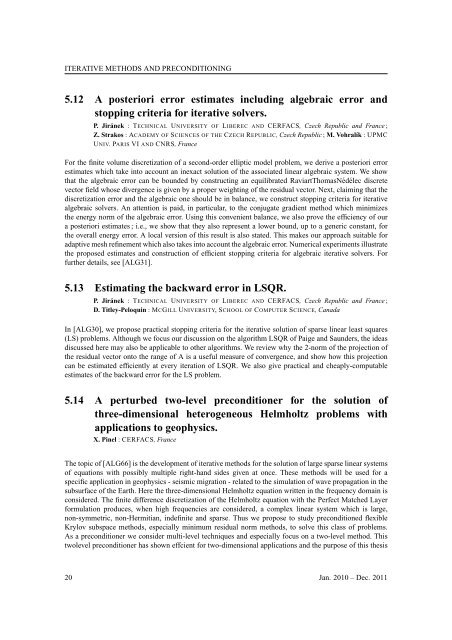CERFACS CERFACS Scientific Activity Report Jan. 2010 â Dec. 2011
CERFACS CERFACS Scientific Activity Report Jan. 2010 â Dec. 2011
CERFACS CERFACS Scientific Activity Report Jan. 2010 â Dec. 2011
Create successful ePaper yourself
Turn your PDF publications into a flip-book with our unique Google optimized e-Paper software.
ITERATIVE METHODS AND PRECONDITIONING<br />
5.12 A posteriori error estimates including algebraic error and<br />
stopping criteria for iterative solvers.<br />
P. Jiránek : TECHNICAL UNIVERSITY OF LIBEREC AND <strong>CERFACS</strong>, Czech Republic and France ;<br />
Z. Strakos : ACADEMY OF SCIENCES OF THE CZECH REPUBLIC, Czech Republic ; M. Vohralík : UPMC<br />
UNIV. PARIS VI AND CNRS, France<br />
For the finite volume discretization of a second-order elliptic model problem, we derive a posteriori error<br />
estimates which take into account an inexact solution of the associated linear algebraic system. We show<br />
that the algebraic error can be bounded by constructing an equilibrated RaviartThomasNédélec discrete<br />
vector field whose divergence is given by a proper weighting of the residual vector. Next, claiming that the<br />
discretization error and the algebraic one should be in balance, we construct stopping criteria for iterative<br />
algebraic solvers. An attention is paid, in particular, to the conjugate gradient method which minimizes<br />
the energy norm of the algebraic error. Using this convenient balance, we also prove the efficiency of our<br />
a posteriori estimates ; i.e., we show that they also represent a lower bound, up to a generic constant, for<br />
the overall energy error. A local version of this result is also stated. This makes our approach suitable for<br />
adaptive mesh refinement which also takes into account the algebraic error. Numerical experiments illustrate<br />
the proposed estimates and construction of efficient stopping criteria for algebraic iterative solvers. For<br />
further details, see [ALG31].<br />
5.13 Estimating the backward error in LSQR.<br />
P. Jiránek : TECHNICAL UNIVERSITY OF LIBEREC AND <strong>CERFACS</strong>, Czech Republic and France ;<br />
D. Titley-Peloquin : MCGILL UNIVERSITY, SCHOOL OF COMPUTER SCIENCE, Canada<br />
In [ALG30], we propose practical stopping criteria for the iterative solution of sparse linear least squares<br />
(LS) problems. Although we focus our discussion on the algorithm LSQR of Paige and Saunders, the ideas<br />
discussed here may also be applicable to other algorithms. We review why the 2-norm of the projection of<br />
the residual vector onto the range of A is a useful measure of convergence, and show how this projection<br />
can be estimated efficiently at every iteration of LSQR. We also give practical and cheaply-computable<br />
estimates of the backward error for the LS problem.<br />
5.14 A perturbed two-level preconditioner for the solution of<br />
three-dimensional heterogeneous Helmholtz problems with<br />
applications to geophysics.<br />
X. Pinel : <strong>CERFACS</strong>, France<br />
The topic of [ALG66] is the development of iterative methods for the solution of large sparse linear systems<br />
of equations with possibly multiple right-hand sides given at once. These methods will be used for a<br />
specific application in geophysics - seismic migration - related to the simulation of wave propagation in the<br />
subsurface of the Earth. Here the three-dimensional Helmholtz equation written in the frequency domain is<br />
considered. The finite difference discretization of the Helmholtz equation with the Perfect Matched Layer<br />
formulation produces, when high frequencies are considered, a complex linear system which is large,<br />
non-symmetric, non-Hermitian, indefinite and sparse. Thus we propose to study preconditioned flexible<br />
Krylov subspace methods, especially minimum residual norm methods, to solve this class of problems.<br />
As a preconditioner we consider multi-level techniques and especially focus on a two-level method. This<br />
twolevel preconditioner has shown effcient for two-dimensional applications and the purpose of this thesis<br />
20 <strong>Jan</strong>. <strong>2010</strong> – <strong>Dec</strong>. <strong>2011</strong>
















